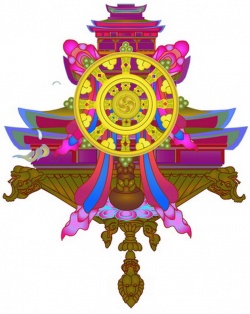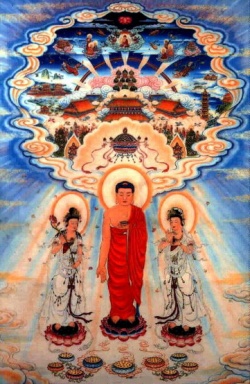On resting with Tilopa…
Recently I have found myself returning to some of the amazingly pithy meditation instructions attributed to Sri Tilopa (988-1069), the well-known Indian Buddhist mahasiddha who was the forefather of the Kagyu lineage. His short, often poetic instructions, are something that help me in my personal meditation practice, as a ground for keeping myself feeling dynamic and internally connected as a chaplain, and in explaining to others the vajrayana perspective regarding what arises within the approach to death. An example of such an instruction is as follows:
If you sit, sit in the middle of the sky.
If you sleep, sleep on the point of a spear.
If you look, look upon the center of the sun.
I Tilopa, who saw the ultimate, am the one who is free of all effort.
The expansive clarity of this type of instruction, for me at least, is very resonant- it offers a way to feel my experience of mind blend into the wideness of space while also experiencing a sense of focus; a relaxed single-pointed experience of breath, sound, transparency of thoughts, and edgelessness. When this experience arises I feel very connected with Tilopa, as well as the other Indian mahasiddhas Naropa and Maitrepa. Sometimes however, I feel that I need a more graded approach to this experience of mind. When this occurs, I tend to lean on Jey Gampopa for support.
More specifically, I rely upon Gey Gampopa’s Precious Garland of the Supreme Path, and even more specifically I come back to the 5th chapter of this wonderful text: The ten things that you should not abandon. I had the wonderful fortune of receiving instruction on this text by the Venerable Khenpo Lodro Donyo, abbot of Bokar Ngedhon Chokhor Ling, in Bodh Gaya in the fall of 1998. This was during one of the many Mahamudra seminars that the late Kyabje Bokar Rinpoche held- truly magical times when we could all sit together under the bodhi tree to recite the 3rd Karmapa’s Mahamudra Aspiration Prayer, spend time in meditation- simultaneously touching our original nature- as well as physically touching the ground that supported the practice of all of the generations of Buddhists who had come before us in Bodh Gaya back all the way to Shakyamuni himself.
It was in that environment, and within that emotional frame of mind, that I came to learn of the ten things that one should not abandon. These ten things are: compassion, appearances, thought, mental afflictions, desirable objects, sickness (suffering and pain), enemies or those who obstruct our practice, methodical step-by-step progress, dharma practices involving physical movement, and the intention to benefit others. Gampopa’s list is very sensible, it is noble in the sense that it seems to be endorsed by Santideva himself; it is imbued with a heartfelt concern for the welfare of others as well as a methodical presentation of the training to see that appearances- be they attractive or not- are just mere appearance. The misapprehension of appearance, or appearance as taken as an independent entity separate from ourselves, is the very cause of our experience of suffering. As with all great dharma texts, it is heartening to see how just one small portion, in this case the 5th chapter of a 28 chapter text can offer the entire path to realizing one’s essential nature.
In looking back at the notebook that I have from the session when Khenpo Rinpoche taught this chapter, I can return to my exuberance not only for this chapter as a whole, but for Gampopa’s explanation of how one should approach the non-abandonment of mental afflictions. As a chaplain, when I am in the hospital, I very rarely meet people who desire to not abandon their experience of suffering: their fear, their psychic pain, their feelings of abandonment, of futility, of anger, or attachment to family- let alone attachment to ideas of how their life should or shouldn’t unfold. This experience isn’t unique to the hospital either- I and most of the people who I know spend a great deal of time fighting with these emotions. Perhaps this is why they are called mental afflictions.
Anger, attachment, pride, jealousy, ignorance. When we really sit quietly with these words they are not just words- they are worlds; worlds of suffering, worlds of feeling like we are right and others are wrong, that we don’t receive the credit or accolades that we deserve, that if only I had this, or was a that, then things would be the way that they should be. On and on and on…
Gampopa advises us to try three modalities with regard to facing and not abandoning our mental afflictions. We can avoid them- that is, avoid whatever causal conditions that might make them arise. We can transform them- or try to transform what these emotions unlock within us. Or finally, we can rest in them as they arise. Whichever modality we tend towards, there are two things to remain mindful of; how we habitually fall into one of these three modalities, and the degree to which we can honestly assess our relationship to that which we struggle with. Each of these ways of facing and not abandoning our mental afflictions can be techniques of liberation or techniques of seductive self-enslavement.
The process of avoidance is a very grounded, stable and well-meaning way of not abandoning our mental afflictions. It honors the way they arise- it honors their root- without forcing us to become affected. This way of approaching difficulties, painful habits, and stubborn aspects of our identities allows us some distance from the “heat” of the moment that comes with embodying our reaction to our mental afflictions. One could even go so far as to say that this modality is somewhat analytical in approach, it is disciplined and measured. The shadow aspect of avoidance is not acknowledging the mental afflictions that bring us pain and suffering. Not much good happens from simply ignoring things, or not letting aspects of ourselves have the light and air that they need to grow. Right now, the shadow of this modality comes to mind in the form of the image of a neglectful parent who doesn’t want to see who their children really are.
Transformation is a common methodology that one finds in the various levels of tantras. It involves playing with the way that we perceive our mental afflictions. This type of restated relationship allows us to meet head on those feelings that would normally make us want to run away. In this way the dross becomes pure; the dirty is seen as clean; and that which torments us achieves the possibility of bringing meaning and peace. True lighthearted transformation- transformation with ease- is hard to effect. Transformation has a terrible shadow side that involves the desire to fix; or more bluntly an inability to meet things as they appear without making them into something positive. As a chaplain, I witness many people struggle with maintaining a relationship with difficulty and pain, uncertainty and loss, and sickness and death without trying to “fix it”. The constancy of a “make-it-better-plan” can be exhausting and create untold suffering. It feels profoundly important to examine how this modality of maintaining a relationship with our matrix of painful emotions can relate to a desire to not allow honesty around what we are feeling and from where the roots of these emotions arise. (Here is a link to the related shadow of spiritually bypassing.)
Resting in whatever arises, the third modality presented by Gampopa, and the favorite of Khenpo Lodro Donyo while he was teaching, is an instruction that one commonly finds within the Kagyu and Nyingma traditions. It is profound- and it also very difficult to do honestly. As we saw earlier, anger, attachment, pride, jealousy and ignorance are powerful. To rest within rage for example- to feel one’s pulse quicken, and heart beat heavier and louder, while one becomes physically tight and flushed, as the explosive heat of anger and impatience engulfs us- is not a particularly comfortable feeling. (For a look at some of the difficulties involved with taking on these fierce emotions, you can read a previous post on Mahakala here.) Then there is the “resting” part. This term gets thrown around very often that I wonder if it doesn’t end up having a multitude of meanings nowadays. I know that I have met Buddhists of other traditions that take the term literally and assume that it is akin to taking a nap or “resting”.
Resting actually refers to maintaining a focused (often described as ‘single-pointed’) awareness of appearance as it arises in the moment. In this way, Tilopa’s instruction from the beginning of this post seems a wonderful way through which we can re-engage the term resting. One quality of resting is being at ease. In this sense when Tilopa refers to three different ways of being- siting, sleeping, and looking- he is referring to three ways that we can rest in what arises. We can do it formally, as in sitting practice. We can do it within the experience of sleep, mind appearances arise when we sleep just as when we are awake. Finally, in looking, perhaps a passive “every day” experience as well.
If you sit, sit in the middle of the sky.
Where is the middle of the sky? The true middle? Where are its edges? Where does the sky end and something else take over? As we sit and remain resting with a sense of ease can we feel the expansive qualities of our minds? Where is the edge of our mind? What does a thought look like? Does it have a source that you can identify? Where do thoughts go when they are no longer so magnetic?
If you sleep, sleep on the point of a spear.
When our thoughts feel sticky and magnetic, when it is hard to not feel drawn into them and let our inner film projector play, what happens when we remain concentrated? What does that “single-pointed” awareness feel like? When we can feel and notice our breath; when we can maintain focused awareness on the way the inner film projector plays; on how a particular thought will hold us within our inner gaze, what do we notice about our experience?
If you look, look upon the center of the sun.
When this focus can be maintained as we look out at the world as it goes by around us, where is the sense of stillness? From where does that arise? What happens to the way that you notice the way that things arise while maintaining a focused awareness upon the expansive quality of our minds? Is there ever not enough room for what arises within our field of reference?
I Tilopa, who saw the ultimate, am the one who is free of all effort.
What if removing all effort was all that you had to do? What would it be like to maintain that within your experience of life?
Instructions such as the ones that Tilopa left behind for us are rare and powerful. It has been roughly one thousand years since Tilopa passed away, and yet through these four lines it is amazing how much of a connection we can feel with him. Five generations after Tilopa, Gampopa further crystalized the importance of being someone who “is free of all effort”. And while there are may pitfalls around how we may feel that we are directly engaging what arises within the moment, there is much beauty in the journey. Perhaps, slowly moving through life, through the wonderous field of appearance, we can increase our sense of ease and relax into an experience of effortlessness. What an amazing thing to aspire towards.



